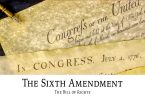Most of the amendments in the Bill of Rights are pretty straightforward in what they mean and require only a basic understanding of the history of the time to understand the intention with which they were written. The Ninth Amendment is somewhat of an anomaly in this list of otherwise easily understandable amendments. In fact, its exact meaning is still being debated among Political Science and Constitutional scholars today.
So, what does the amendment actually say?
The Ninth Amendment
The enumeration in the Constitution, of certain rights, shall not be construed to deny or disparage others retained by the people.
What Does it Mean?
It’s easy to see how the wording of this amendment could be confusing. In fact, while the debate over its exact meaning and intent is still being debated today, the reason it was written is an undisputed historical fact. After the Constitution was written, each individual state had to ratify it, with a majority being required to ratify it for the Constitution to become the new law of the land. Supporters of the Constitution as it was were called Federalists, and those who opposed it were called Anti-Federalists. The big complaint of the Anti-Federalists was that the Constitution did not have a bill of rights.
Prominent Federalists argued that a bill of rights would be dangerous. By listing (i.e., enumerating) the rights of the people in the Constitution, it might be construed by the courts in later cases, or even by Congress, that the people only had the rights listed, and no others.
Of course, it was an impossible task to list out every single right of the people. Federalists were concerned the government would limit any of the rights of the people that were not listed in a bill of rights. But, because the Anti-Federalists insisted on a bill of rights in exchange for them voting to ratify the Constitution, one was added. The Bill of Rights was largely the work of James Madison, with input from a few other Federalists.
The Ninth Amendment was Madison’s attempt to let the government know that just because a particular right of the people was not mentioned by name in the Bill of Rights did not mean that right did not exist, or that the government could infringe upon it. But, he worded it so convolutedly that it has hardly ever been used by the courts in making Constitutional decisions. In fact, a Supreme Court nominee who ultimately failed his confirmation hearing in 1987, Robert Bork, even went so far as to say that judges should not attempt to guess at the true meaning of the Ninth Amendment.
This public denial that we should try to learn the meaning of the Ninth Amendment led political scholars to try to do just that. A number of theories have emerged since then as to the true meaning of the Ninth Amendment. The most common meaning assigned to it today is that the amendment is letting the government know that just because a right is not enumerated in the Bill of Rights does not mean it does not exist. Of course, if a right isn’t listed, how do we know what it is? And, do unenumerated rights belong to everyone? How can we determine what they are?
The basic meaning of the amendment is clear, but the argument it raises about unenumerated rights is unresolved to this day, more than two centuries after it was written.






